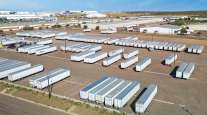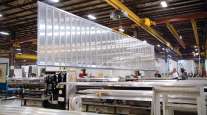Trailer Orders Jump in October as Order Season Begins

Trailer orders jumped 50% in October, the typical start of the order season for the upcoming year, according to preliminary results from ACT Research Co.
Orders reached 32,000 compared with 21,312 in the 2016 period, according to ACT. Dry van and flatbed orders increased while reefer trailers slipped.
“A lot of it was dry van driven. Flatbeds came to the party as well,” said Frank Maly, ACT’s director of commercial vehicle transportation analysis and research.
ACT will adjust its preliminary figure when the final tally is available from trailer makers.
Maly suggested the recent court decision about Phase 2 of the greenhouse gas rule also may well have pushed some fleets over the line into ordering, he said.
The Court of Appeals for the District of Columbia issued a stay Oct. 27 that temporarily halted implementation of a provision in the rule that would have regulated trailer manufacturers for fuel efficiency for the first time beginning Jan. 1.
“Many customers are keeping what they ordered [before the stay] for the time being,” said David Giesen, vice president of sales at Stoughton Trailers. “The market now has the ability to make [business] decisions on devices instead of being mandated, and we will have to give this time to find out what will be demanded going forward from a specification standpoint.”
Said Glen Harney, chief sales officer at trailer manufacturer Hyundai Translead: “We are postponing the [compliance] certification until further notice and the status of GHG 2 regulations has been decided.”
Wabash National Corp. expects the federal mandate implementing electronic logging devices by Dec. 18 will lead to “capacity tightening, improved pricing dynamics within the industry and ultimately stronger demand for trailers,” Wabash President Brent Yeagy said during an earnings call with stock analysts Nov. 1.
Meanwhile, the research company FTR pegged preliminary net orders at 33,600 units.
At the same time, backlogs for reefer trailers are down over 10,000 units, or about 45%, from a year ago, said Don Ake, FTR’s vice president of commercial vehicles.
“My best explanation is you had all these demand drivers increasing the refrigerated market and the fleets were ordering and the trailer makers were building. At some point, you catch up,” he said, referring to drivers such as regulations and an increasing number of products moving in temperature-controlled trailers that used to be hauled in dry vans.
Trailer makers continue to be optimistic, but that is tempered by rising commodity prices.
For East Manufacturing, “October was our biggest order month in 50 years on record,” topping East’s former peak reached last December, said Dave de Poincy, the company’s president.
East Manufacturing designs, builds and sells only all-aluminum trailers in the dump, platform and refuse segment. East is on track for about 25% growth year-over-year overall, de Poincy said, driven by a big increase in flatbed business, which has much lower margins “so bottom line growth is very challenging.”
Also, material cost increases are “eating any chance of higher margins. The London Metal Exchange [a futures exchange] metal cost is at an all time high, steel and copper are rising so we have no choice but to raise prices where we can,” he said.
“The dump trailer business has not materialized for spring needs yet, so we have concerns there as well,” de Poincy added. “Normally we see that happen in October.”
Utility Trailer Manufacturing Co. found orders for dry vans and flatbeds hit the highest point of the year in October, which was also the second-biggest month for reefer orders in 2017, said Brett Olsen, Utility’s marketing manager.
“We are cautiously optimistic. The market is just slightly above replacement cycle levels, and GDP seems strong enough to keep the economy generating freight,” Olsen said.
At Hyundai Translead, demand is still strong, Harney said. “In my opinion 2018 could be similar to 2017 for vans and reefers.”
At Strick Trailer, “2018 is shaping up very nicely. Backlogs are strong and quote requests are rolling in at record numbers. Our custom line if running at full capacity,” said Charles Willmott, chief sales officer at Strick Group.
“Currently, our forecast for the dry van business is for a strong 2018 and a modest correction in 2019,” Willmott said.
Stoughton Trailer is not seeing a pull back in demand, either, and agreed commodity prices are creeping up, Giesen said. “Not dramatic, but certainly not decreasing. Also, there is still capacity for growth, if the industry demands it. Demand has been high for an extended period of time, going on three years. Is it the new normal?”





